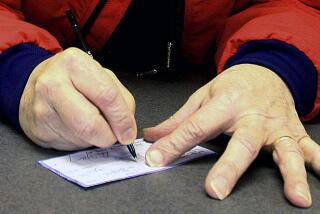Traveler’s Checks Sinking Beneath a Sea of Plastic
- Share via
The rotary dial telephone. The turntable. The black-and-white television. And soon, perhaps, the traveler’s check.
As ATMs proliferate, as the world’s merchants grow comfortable with charge-card sales, as the euro simplifies money-trading on the continent Americans visit most, Karl Malden’s favorite tourist precaution is beginning to look increasingly like a device from a bygone era.
These days, “it’s all plastic,” says Lois Mitchell, manager of the leisure division of Burbank-based Hoffman Travel. She estimates that as many as 99 of every 100 clients do without traveler’s checks. Industry statistics also show check sales slumping as overall travel spending booms.
So what are these travelers doing for money? Hint: Visa now offers its cardholders 531,000 ATM locations worldwide; MasterCard, 529,000; American Express, 340,600. (Their Internet sites, https://www.visa.com, https://www.mastercard.com and https://www.americanexpress.com, include worldwide specifics on where those ATMs can be found. Remember that some overseas ATMs accept only four-digit personal-identification numbers.)
The traveler’s check is not quite obsolete. Even while adding ATM sites daily, these three charge-card industry leaders are among the companies still selling the checks. And many veteran travelers, including one who sits at the desk next to mine in our office, say they value the sense of security that comes with noncash, non-charge-card buying power.
When I last wrote about this subject nearly four years ago, American Express, the leading seller of traveler’s checks, had just hit a plateau. AmEx, which sold $25.3 billion in traveler’s checks in 1990, sold $25.6 billion in 1995. The numbers have been dropping since: $23.6 billion in 1998, $23.3 billion in 1999.
If that doesn’t seem a dramatic decline, consider how fast the travel trade has been growing: Between 1990 and 1998, Americans’ spending on domestic travel rose 46%, and our spending on foreign travel rose 52%, according to the Washington-based Travel Industry Assn. of America.
Visa executives say sales of their traveler’s checks in the U.S.--$12.5 billion in 1994--have fallen almost 50% in the last five years. That’s “undoubtedly due to people switching to plastic or withdrawing cash from ATMs,” says spokesman Colin Baptie.
Similarly, Harry Joo, controller for Crystal Cruise Line, estimates that as many as 80% of passengers used traveler’s checks to settle their accounts in the early 1980s. By 1996 that figure had dwindled to less than 10%. Now, Joo says, it’s less than 5%.
Mitchell of Hoffman Travel recommends that clients use charge cards whenever possible and pay off their balances each month so that interest doesn’t accumulate. She says many of her customers are lured by the ability to rack up mileage points through charge-card spending, but she suggests that a card’s greatest advantage is that when a consumer doesn’t get what he or she paid for, “the credit card company is going to be your ombudsman.”
I haven’t purchased a traveler’s check in at least five years. Instead, I usually carry a modest amount of cash, use charge cards for spending whenever possible and occasionally use ATMs for cash advances from American Express or Visa or withdrawals from my checking account.
To be sure, the traveler’s check still has selling points. It offers a degree of protection that other modes of spending cannot. Unlike the cash you carry or withdraw from an ATM, a traveler’s check is designed to be worthless in the hands of someone who can’t match your signature.
My colleague Susan Spano, who is plenty savvy about travel tactics, still likes to have some traveler’s checks on hand if she’s headed to an overseas destination off the beaten path. She relied on ATMs and didn’t bother with traveler’s checks on a trip to Rome last year. But for an assignment in Tonga in March, she took about $500 in cash and another $500 in traveler’s checks.
Budget travel guru Arthur Frommer also continues to recommend traveler’s checks for the safety they afford. And at the Automobile Club of Southern California, spokesman Jeffrey Spring says, “We continue to recommend them as a form of carrying cash safely, but we also have evolved.” That evolution means the club suggests that its members use a mixed portfolio of spending methods.
The traveler’s check has always been an appealing product for the companies that issue them: A customer pays up front, and the company collects interest on all those deposits while travelers gradually spend or hoard their checks. But those travelers don’t always win when it comes to buying power and convenience.
If you buy an item with a charge card abroad, you’ll probably end up getting an exchange rate that’s 5% to 10% better than if you buy it with traveler’s checks or trade currencies before buying. That’s because charge-card transactions are conducted within a few percentage points of the advantageous “interbank” exchange rates used by banks trading in increments of $1 million or more. Trading traveler’s checks or foreign cash at banks, hotel desks or exchange kiosks, you get less advantageous rates.
Then there’s the hassle of buying the checks, signing them once, and keeping a record of how they’ve been spent--a bother, but (as check fans would quickly note) perhaps not quite the bother of losing your money.
So, just as you can still find record turntables here and there, traveler’s checks probably won’t vanish any time soon. And as an American Express official notes in the company’s most recent annual report, in forgotten desk drawers and misplaced wallets around the globe, there is about $6.2 billion in unused traveler’s checks, with no expiration dates.
Christopher Reynolds welcomes comments and suggestions, but cannot respond individually to letters and calls. Write Travel Insider, Los Angeles Times, Times Mirror Square, Los Angeles, CA 90053, or send e-mail to chris.reynolds@latimes.com.
More to Read
Sign up for The Wild
We’ll help you find the best places to hike, bike and run, as well as the perfect silent spots for meditation and yoga.
You may occasionally receive promotional content from the Los Angeles Times.







